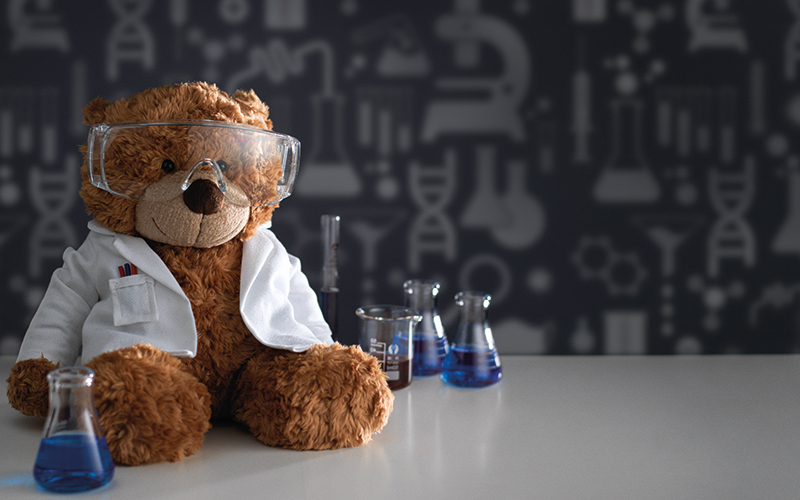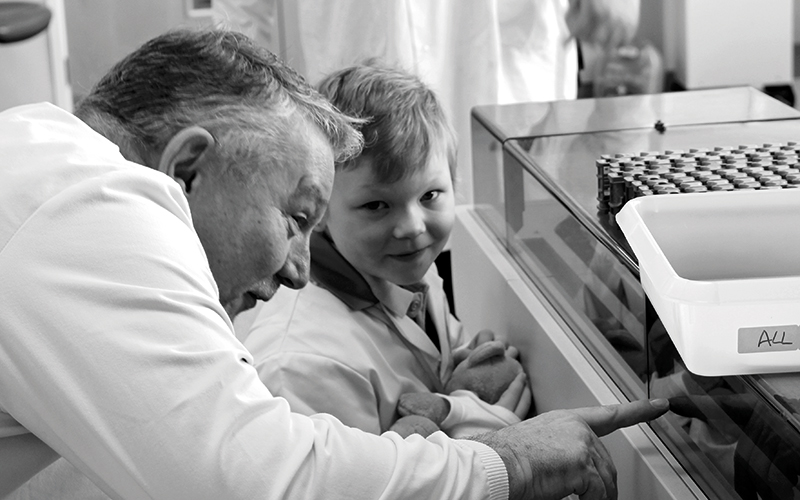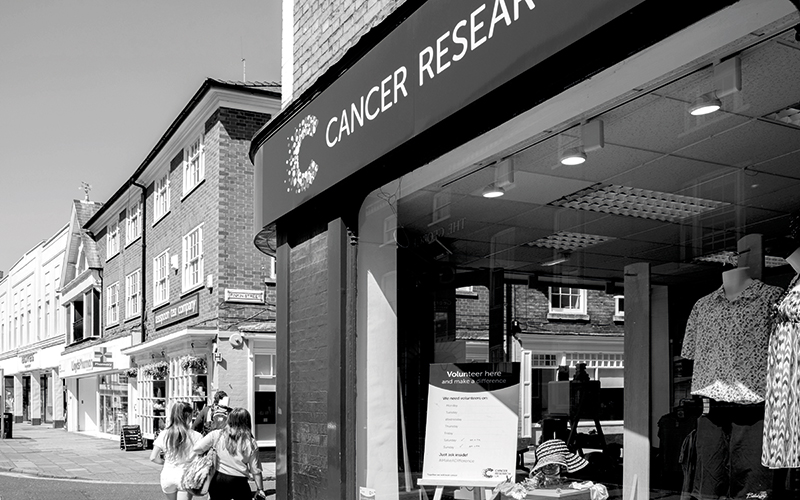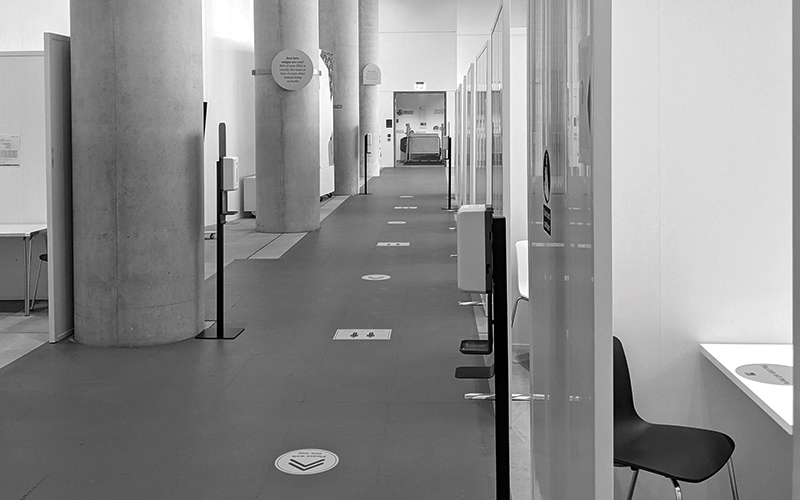We hear from the charity Harvey’s Gang and four other organisations about voluntary work, how they have coped in the pandemic and what their hopes are now that restrictions are easing.

Malcolm Robinson
Founder, Harvey’s Gang
Harvey’s Gang provides laboratory tours for young people to allay fear of needles and blood sample collection. The tours help enable the young person to take ownership of their healthcare, leading to increased compliance with treatment.
We show the young person the interior of the laboratory, so that they can meet the biomedical scientists and see all of the amazing equipment. They are able to peer down the microscope and examine their own blood cells, wonder in fascination that their neutrophils are present in sufficient numbers for their next bout
of chemotherapy, and be amazed by the huge chemistry analysers with their probes darting back and forth.
We operate in a range of hospitals and are hoping to enable the programme in all UK hospitals, eventually.
“By the end of the tour you have a bond that will never be broken”
Covid-19 arrives
In February last year, I attended the Haematology and Transfusion Science Scientific meeting in Edinburgh, just before the devastating effects of COVID-19 were felt and the lockdown came into force.
I remember walking down Princes Street buying hand sanitiser (you were not allowed hand sanitisers on the airline!). I visited the super-talented Tammy Hanson at The Royal Sick Children’s Hospital in Edinburgh. Tammy has rolled out Harvey’s Gang tours and educates her visitors with scientific experiments and visual aids. She has blood film slides from reptiles for comparison to children’s films.
At the event I co-presented with 10-year-old Harvey’s Gang member Arabella (Bella) Muir. I had the opportunity beforehand to spend time with her and her father talking about her, her illness and the impact that her Harvey’s Gang tour had made on her life. I talked to Bella in front of the scientific audience and was amazed by the knowledge that she was able to demonstrate.
Then the pandemic hit. Harvey’s Gang tours stopped – as did access to all hospitals. I couldn’t even get into our local hospital where all of our Harvey’s Gang materials were being stored.

Harvey’s Gang continues to be maintained as a charity and thank you all for your support, but please remember we do need your support.
In Guernsey, in August 2020, despite the global pandemic, Zoe Andrews started Harvey’s Gang tours in a COVID-secure environment. I have to say a huge thanks to Zoe – she is an amazing biomedical scientist, and Mum to the fabulous Harriet. Zoe sourced funds locally to help her develop Harvey’s Gang. Then Harriet designed Harvey’s Gang Christmas cards and we were able to sell them, raising over £300 for the Harvey’s Gang charity.
Harvey’s Gang started after we said farewell to six-year-old Harvey Baldwin who had acute myeloid leukaemia.
The 109 laboratories that will be able to perform tours will generate a huge amount of positive advertisements for biomedical scientists and the jobs that we love. And we will be able to showcase and educate so many young patients, giving them a better patient journey and perhaps a better life. Harvey’s Gang tours are an emotive journey that the biomedical scientist shares with their unknown patient. By the end of the tour you have a bond that will never be broken. Three that spring to mind are:
1: Toby needed a heart transplant. He launched Harvey’s gang at St Richard’s Chichester and helped launch Harvey’s Gang at Great Ormond Street Hospital (GoSH). Toby received his heart transplant at GoSH, and Zoe and I visited GoSH and spent time with his parents, just to chat, whilst Toby was in isolation post-transplant. We trust after the pandemic Toby will come back and name our blood grouping Vision analyser “Toby”.
2: Michael launched Harvey’s Gang at Southampton University Hospital and we named their Vision Max Blood grouping analyser “Michael”. I accompanied Michael on his tour as a trainee scientist. Michael and I then co-presented at an international nephrology meeting in Glasgow. A natural presenter with humour, he is a star of the future.
3: Francesca launched Harvey’s Gang at Worthing, televised on the BBC. My nickname for her since the tour has been professor. Two years later, Francesca and I co-presented at a Southeast Coast Transfusion Education Day, where she overshadowed me presenting with authority and knowledge. So humbling.
Everything for the patient
Harvey’s Gang is stable and able to grow, but we need all of you to take us forward within your hospitals and laboratories and support us by sharing your incredible stories and helping raise funds.
We improve the young patient’s journey, even overcome needle phobias and help with their healthcare compliance. We make a huge difference to ourselves and our profession, too. We sometimes sideline the reasons for our amazing commitment to our patients and forget why we chose this profession – we lose the patient in our career journey. Harvey’s Gang gives us this back. We realise everything we do is because of the patient, their families and their fears. It make us feel 10 feet tall.
“Then the pandemic hit. Our tours stopped – as did access to all hospitals”
Get involved
Harvey’s Gang is me trying to persuade you to introduce patients into laboratory practices. I help and guide you and share our documentation, help persuade other teams within your hospital to agree to the idea. All Harvey’s Gang sites are standardised in that we have the “little” white coats and goody bags, we help each other, continually improving paperwork. Please join in on Facebook and Twitter and awareness at your local sites. I also need help from you to continue our journey; want to get involved? Please e-mail me on [email protected].
Dr Naim Akhtar
Consultant Haematologist & Donor Medicine, NHS Blood & Transplant
NHS Blood and Transplant (NHSBT) relies on voluntary donors who give the gift of blood freely to help save and improve many lives of patients in need. NHSBT is grateful to over 800,000 altruistic regular blood donors every year. The coronavirus pandemic created a potential challenge, due to blood donors not being able to donate because of travel and lockdown restrictions. The NHSBT blood operational and leadership team met on a weekly basis to monitor predicted supply and demand and make any contingency arrangements.
During the first lockdown, elderly donors over the age of 70 were asked to self-isolate and be shielded. NHSBT wrote to donors over 70 to temporarily suspend their records, until it was deemed safe for them to resume. As the number of donors in this age group was relatively small, this did not significantly impact
on the overall blood supply.
The main challenge for NHSBT was to ensure the safety of donors and staff and avoid blood donation sessions being a source of coronavirus transmission. The government deemed blood donation to be an essential activity. Collections had to be maintained despite reductions in staffing levels (co-morbidities and shielding) and donors attending. All donation centres were made COVID-19 secure, with donors being able to sit two metres apart, regular disinfection and cleansing regimens and mandatory wearing of face coverings for donors and staff. For smaller donation centres, this meant reducing numbers of donors who could attend at any one time. The issue of mandatory face coverings was risk assessed. Whereas supermarkets, transportation and other areas of the NHS were able to operate an exemptions policy for individuals unable to wear or tolerate a face covering, NHSBT could not comply, as social distancing was not always possible. Staff had intimate contact with donors for health screening, to perform the haemoglobin check, cleanse the skin at the venepuncture site, perform the venepuncture and take the donation. In addition, if the donor had any adverse event during or after donation, the staff would need to provide clinical care.
NHSBT was also commissioned to collect convalescent plasma from recovered COVID-19 patients as part of national trials to use in the treatment of seriously ill coronavirus patients, which meant balancing an urgent need to collect plasma concurrently with the duty to collect and maintain sufficient national blood supplies.
Despite the obvious challenges, NHSBT was deemed to be successful due to hard work, commitment and the dedication of staff in ensuring both the life-saving plasma and blood collections remained on track. As a result, I believe NHSBT is a more resilient organisation and has embraced home working for non-donor-facing staff. However, ultimately voluntary donors are the ones to be commended for rising to the pandemic, and continuing to save and improve many lives through their on-going selfless gifts of blood donation. A big thank you to all our wonderful donors!

Executive Director of Research and Innovation, Cancer Research UK
The coronavirus pandemic has had a profound effect on all facets of public and private life. People with cancer have been particularly vulnerable, both at risk of contracting the virus as well as facing disruption to their standard of care. The lifesaving work of our researchers and clinicians has also been severely affected, and we’ve had to make very difficult decisions.
Like many charities, Cancer Research UK has been hit hard over this past year. Almost every aspect of our fundraising has been impacted by COVID-19, including the temporary closure of our shops and the cancellation of in-person fundraising events.
Overall, we’re predicting a drop in income of £300m over three years.
We reacted swiftly at the beginning of the pandemic to reduce costs. We moved staff to 80% pay and hours for four months, furloughed 60% of staff and cut £44m from our research. However, despite these early actions, we were only able to fund half the new research that we usually would last autumn – about £45m less.
We’re doing everything we can to find more financial support, including calling on the Government for help, and our funding model will be flexible so that we can spend more, if we can. We still have great ambition, are still the largest charitable funder of cancer research in the world and will continue to fund the very best scientists.
Even in just the past few months, newly published Cancer Research UK-funded work has produced novel insights and strides into tackling the disease. It’s ranged from lab research into how we can exploit cancer’s nutritional needs to reported results from clinical trials that have shown how new treatments are showing great promise for people with mesothelioma, and secondary central nervous system lymphoma patients.
Our centre for drug development, who run early phase cancer trials, not only managed to keep their cancer trials going during the pandemic, but, at no extra cost to the charity, they lent their expertise to fight the COVID-19 pandemic. They are running the Spike1 trial, which is testing if a drug called camostat can help stop people with COVID-19 developing severe disease and prevent them from deteriorating and being hospitalised.
Looking to the future means building the best researcher community we can. The launch of our first diversity data grant funding report and action plan to address systemic underrepresentation in research is one of the steps we’re taking in our role in creating a better research environment that can help us reach our mission of beating cancer for everyone.
In these times, we are more grateful than ever for the generous donations of our supporters, and the resilience of the researchers and clinicians who have continued to make life-changing progress throughout the pandemic.
Dr Praveen Paul
Co-Founder, Pint of Science
The annual Pint of Science festival brings the latest scientific discoveries to people through thousands of public events across the world. We are a grassroots organisation run by volunteers, many of whom are scientists or researchers.
The pandemic and lockdown has seen nearly all our in-person events cancelled and moved online.
As the entire internet-connected world moved things online, we found ourselves not only learning a new way of doing things but also competing against Netflix and other streaming services. Before, guests simply had to turn up at the venue and they would instantly become our committed audience. Now, if we were not entertaining or engaging enough, our audience could very easily leave – simply by closing their online browser.
It was clear to us that live shows, rather than pre-recorded content, would be the way to engage people and make them feel valued and part of an online show. We initially experimented with a small number of online shows and tried different formats. The skills required were completely different to in-person events, but we are fortunate to have a large group of enthusiastic volunteers who are keen and willing to learn and adapt. Learning to create, produce and host online shows as a team gave us a much-needed outlet and sense of community.
We found our online shows attracting a new audience: teenagers (who previously may not have been able to attend the events held in bars and pubs) and an older population. We even received this heart-warming email: “Just to say how much we have enjoyed the series of talks and the time and effort put in by all the participants. Absolutely wonderful and uplifting in this very trying time. From two 70 year olds.”
Despite reaching new age groups and people in different countries, our audience has become exclusive because our shows are now limited to people who have access to the internet.
An online show feels very different, both for the presenters and the audience. Some Pint of Science countries choose to broadcast their live shows straight to YouTube and rely on the live chat to engage with the audience. However, it can be disconcerting when you can’t see your audience, and so some countries try to recapture the intimate and cosy feeling of being in a pub or café by creating online meetings where we can all see one another and have an informal chat before we hear from the scientists.
Pint of Science Kenya joined for the first time last year and ran live online shows covering antimicrobial resistance, oncology and even a quiz! Our team in Brazil, where Pint of Science is in nearly 200 cities, ran an incredible 300 online shows over three days.
In the UK we’re now looking to run around 60 online shows during 17–20 May 2021 involving nearly 40 UK universities and research institutions. Although it’s 10 times smaller than our usual number of in-person events it’s still a lot of content. However, we aim to show the breadth of research, give the audience a choice of what to view, and equip scientists to communicate science and research effectively – the importance of which has been highlighted by the pandemic.
Moving forward it has been a beneficial experience for everyone involved, and once social distancing is behind us, it is very likely that we continue to run some online shows. We can sometimes feel “stuck” behind screens wondering if there is any point, but we can never truly know our impact or how it affects the people watching. Just before Christmas an anonymous hand-written note arrived to our registered postal address which simply said: “Here is a donation, keep up the good work, thank you” – these small acknowledgements make it worthwhile.
Pint of Science takes place in nearly 30 countries during the week starting 17 May. See pintofscience.com for more info.

Associate Research Director, Francis Crick Institute
In March 2020, when the national lockdown was announced, the Crick, like many other scientific institutions found itself with a stark choice. Full closure of the institute would have compromised its facilities and infrastructure, notably our animal facility. At the time, the extent of the spread of the SARS-CoV-2 virus was unknown due to the restricted testing capacity. Crick researchers with clinical commitments at London hospitals were particularly aware of the plight of healthcare workers who bore the brunt of infection with insufficient protective equipment and testing at the beginning of the pandemic.
The Crick quickly realised it could keep the institute partially functioning and, at the same time, provide an essential testing service to frontline NHS staff, care homes and patients. In record time, a collaboration between the Crick, UCL and UCLH set up a COVID high-throughput PCR testing pipeline, involving over 300 Crick employee volunteers. The Crick science technology platforms (STPs), which underpin research at the institute, played a central role in setting this up.
So, since April, the Crick has provided weekly testing for healthcare workers from 10 North London hospitals, 150 care homes, community and ambulance services, as well as Crick staff. To date, a bank of over 400,000 samples has been established as a “Legacy Cohort”. With informed consent, Crick researchers will match these samples with individuals to study how factors like age, sex, ethnicity and medical history impact the risk of infection. Legacy cohort participants also include Crick staff. Additional swab and blood samples taken over the next two years will be a fantastic resource for studies of emerging variants and their impact on vaccination, immunity and infection.
Weekly testing made it possible to keep the Crick open for staff involved in the testing pipeline or in COVID research. The multidisciplinary expertise across the institute facilitated research on the virus itself, as well as on the host response to infection. While for some groups the SARS-CoV-2 virus was a natural study subject, others repurposed their labs to help develop new technology, such as sensitive antibody tests, which are now being used to measure the response to vaccination. Containment facilities set up for influenza virus research were used for virus propagation and sample inactivation prior to PCR and for the development of high-throughput virus neutralisation assays to determine the efficacy of antibodies in preventing virus entry into cells.
Finally, at the beginning of 2021, again with the involvement of a large body of volunteers and in partnership with UCLH, the Crick became a national vaccination centre.
What has happened to “normal” Crick research in the meantime? Until the end of the first lockdown, no non-COVID-related research was allowed to take place and we started a gradual re-opening of the labs from June 2020. The inevitable reduction in our mouse breeding facility meant a delay in re-establishing mouse lines that affected many labs for a few months longer. However, over the summer and autumn, volunteers who had been working on the testing pipeline returned to their labs as day-to-day testing was gradually taken over by the STPs.
While other research has restarted, COVID research is ongoing at a similar pace as there is no shortage of research questions. A regular COVID Research Forum at the Crick is active in discussing findings from different labs and facilitating collaboration. Despite the recent lockdown, science at the Crick has continued and the Crick lecture series and weekly discussion groups (all via Zoom) have been reinitiated.
Apart from the reduced number of colleagues in the building, regular testing, the strict wearing of masks and social distancing, the endless Zoom meetings and the impossibility of having an “end of the day” chat at the bar, the Crick seems almost normal these days.
Image credit | Shutterstock
